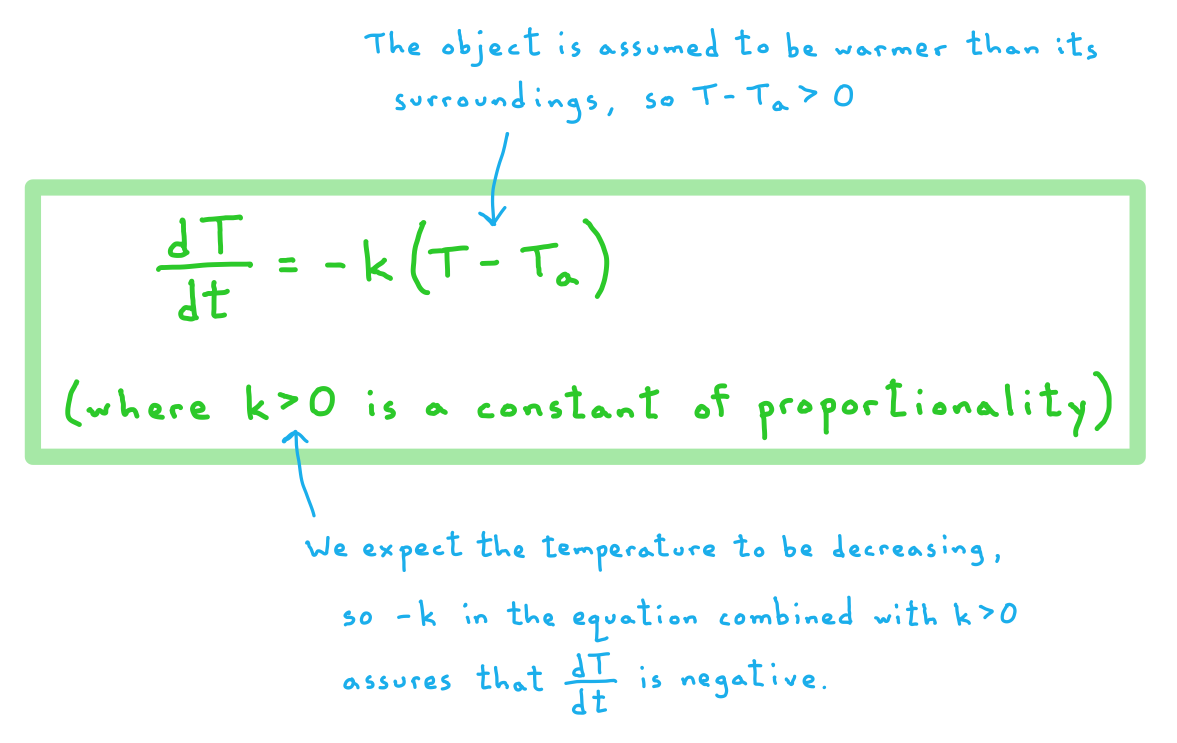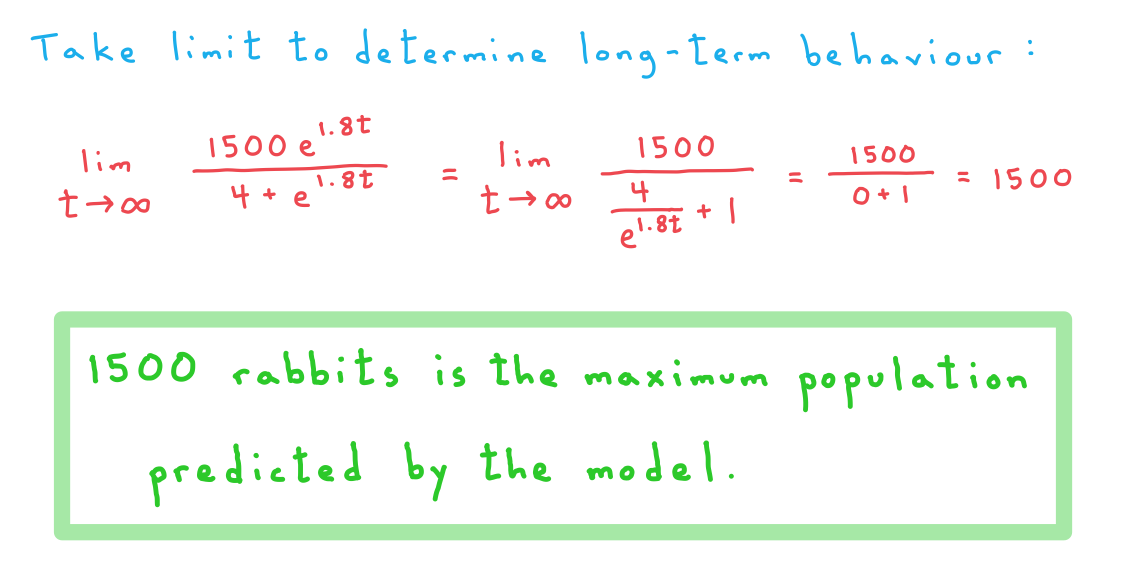Modelling with Differential Equations
Why are differential equations used to model real-world situations?
- A differential equation is an equation that contains one or more derivatives
- Derivatives deal with rates of change, and with the way that variables change with respect to one another
- Therefore differential equations are a natural way to model real-world situations involving change
- Most frequently in real-world situations we are interested in how things change over time, so the derivatives used will usually be with respect to time t
How do I set up a differential equation to model a situation?
- An exam question may require you to create a differential equation from information provided
- The question will provide a context from which the differential equation is to be created
- Most often this will involve the rate of change of a variable being proportional to some function of the variable
- For example, the rate of change of a population of bacteria, P, at a particular time may be proportional to the size of the population at that time
- The expression ‘rate of’ (‘rate of change of…’, ‘rate of growth of…’, etc.) in a modelling question is a strong hint that a differential equation is needed, involving derivatives with respect to time t
- So with the bacteria example above, the equation will involve the derivative
- Recall the basic equation of proportionality
- If y is proportional to x, then y = kx for some constant of proportionality k
- So for the bacteria example above the differential equation needed would be
- The precise value of k will generally not be known at the start, but will need to be found as part of the process of solving the differential equation
- It can often be useful to assume that k > 0 when setting up your equation
- In this case, -k will be used in the differential equation in situations where the rate of change is expected to be negative
- So in the bacteria example, if it were known that the population of bacteria was decreasing, then the equation could instead be written
Worked Example
a)
In a particular pond, the rate of change of the area covered by algae, A, at any time t is directly proportional to the square root of the area covered by algae at that time. Write down a differential equation to model this situation.

b)
Newton’s Law of Cooling states that the rate of change of the temperature of an object, T, at any time t is proportional to the difference between the temperature of the object and the ambient temperature of its surroundings, Ta , at that time. Assuming that the object starts off warmer than its surroundings, write down the differential equation implied by Newton’s Law of Cooling.

The Logistic Equation
What is the logistic equation?
- The differential equation
is a very simple example of a model in which the rate of change of a population at any moment in time is dependent on the size of the population (N) at that time
- The solution is
(where A > 0 is a constant)
- If k > 0, this represents unlimited exponential growth of the variable N
- The solution is
- In many real-world contexts (for example when considering populations of living organisms), unlimited growth is not a realistic modelling assumption
- For reproducing populations it is logical to assume that the rate of change of the population will be dependent on the size of the population (more rabbits means more production of baby rabbits!)
- But there are generally limiting factors on populations that prevent them from growing without limits
- For example, availability of food or other resources, or the presence of predators or other threats, may limit the population that can exist in a given area
- A logistic equation incorporates such limiting factors into the model, and therefore can provide a more realistic model for real-world populations
- The standard logistic equation is of the form
- t represents the time (since the moment defined as t = 0) that the population has been growing
- N represents the size of the population at time t
-
is a constant determining the relative rate of population growth
- For the models dealt with here it is most common to have k > 0, with a larger value of k representing a faster rate of change
is a constant that places a limit on the maximum size to which the population N can grow
- For a population model it can be assumed that a > 0
- For k > 0 and an initial population N0 such that 0 < N0 < a, the population N will grow and will converge to the value a as time t increases
- For k > 0 and an initial population N0 such that 0 < N0 < a, the population N will shrink and will converge to the value a as time t increases
- There are other forms of logistic equation
- The exact form of the logistic equation you are to use will always be given in an exam question
How do I solve problems that involve a logistic equation model?
- Solving the differential equation will generally involve the technique of separation of variables
- Usually this will also involve rearranging one of the integrals using partial fractions (see the worked example below for an example)
- You will usually be given ‘boundary conditions’ specific to the context of the problem
- For example, you may be told the initial population at time t = 0
- These conditions will allow you to work out the exact value of any integrating constants that occur while solving the differential equation
- You will need to take account of the context of the question in answering the question or in commenting on the model used
Worked Example
A group of ecologists are studying a population of rabbits on a particular island. The population of rabbits, N, on the island is modelled by the logistic equation
where t represents the time in years since the ecologists began their study. At the time the study begins there are 300 rabbits on the island.
a)
Show that the population of rabbits at time t years is given by format('truetype')%3Bfont-weight%3Anormal%3Bfont-style%3Anormal%3B%7D%3C%2Fstyle%3E%3C%2Fdefs%3E%3Ctext%20font-family%3D%22Times%20New%20Roman%22%20font-size%3D%2218%22%20font-style%3D%22italic%22%20text-anchor%3D%22middle%22%20x%3D%226.5%22%20y%3D%2231%22%3EN%3C%2Ftext%3E%3Ctext%20font-family%3D%22math16f1ab71ca1b4679edc1ddd12c2%22%20font-size%3D%2216%22%20text-anchor%3D%22middle%22%20x%3D%2222.5%22%20y%3D%2231%22%3E%3D%3C%2Ftext%3E%3Cline%20stroke%3D%22%23000000%22%20stroke-linecap%3D%22square%22%20stroke-width%3D%221%22%20x1%3D%2233.5%22%20x2%3D%22103.5%22%20y1%3D%2224.5%22%20y2%3D%2224.5%22%2F%3E%3Ctext%20font-family%3D%22Times%20New%20Roman%22%20font-size%3D%2218%22%20text-anchor%3D%22middle%22%20x%3D%2253.5%22%20y%3D%2217%22%3E1500%3C%2Ftext%3E%3Ctext%20font-family%3D%22Times%20New%20Roman%22%20font-size%3D%2218%22%20text-anchor%3D%22middle%22%20x%3D%2275.5%22%20y%3D%2217%22%3Ee%3C%2Ftext%3E%3Ctext%20font-family%3D%22Times%20New%20Roman%22%20font-size%3D%2213%22%20text-anchor%3D%22middle%22%20x%3D%2282.5%22%20y%3D%2212%22%3E1%3C%2Ftext%3E%3Ctext%20font-family%3D%22math16f1ab71ca1b4679edc1ddd12c2%22%20font-size%3D%2212%22%20text-anchor%3D%22middle%22%20x%3D%2288.5%22%20y%3D%2212%22%3E.%3C%2Ftext%3E%3Ctext%20font-family%3D%22Times%20New%20Roman%22%20font-size%3D%2213%22%20text-anchor%3D%22middle%22%20x%3D%2293.5%22%20y%3D%2212%22%3E8%3C%2Ftext%3E%3Ctext%20font-family%3D%22Times%20New%20Roman%22%20font-size%3D%2213%22%20font-style%3D%22italic%22%20text-anchor%3D%22middle%22%20x%3D%2299.5%22%20y%3D%2212%22%3Et%3C%2Ftext%3E%3Ctext%20font-family%3D%22Times%20New%20Roman%22%20font-size%3D%2218%22%20text-anchor%3D%22middle%22%20x%3D%2244.5%22%20y%3D%2243%22%3E4%3C%2Ftext%3E%3Ctext%20font-family%3D%22math16f1ab71ca1b4679edc1ddd12c2%22%20font-size%3D%2216%22%20text-anchor%3D%22middle%22%20x%3D%2257.5%22%20y%3D%2243%22%3E%2B%3C%2Ftext%3E%3Ctext%20font-family%3D%22Times%20New%20Roman%22%20font-size%3D%2218%22%20text-anchor%3D%22middle%22%20x%3D%2270.5%22%20y%3D%2243%22%3Ee%3C%2Ftext%3E%3Ctext%20font-family%3D%22Times%20New%20Roman%22%20font-size%3D%2213%22%20text-anchor%3D%22middle%22%20x%3D%2277.5%22%20y%3D%2238%22%3E1%3C%2Ftext%3E%3Ctext%20font-family%3D%22math16f1ab71ca1b4679edc1ddd12c2%22%20font-size%3D%2212%22%20text-anchor%3D%22middle%22%20x%3D%2283.5%22%20y%3D%2238%22%3E.%3C%2Ftext%3E%3Ctext%20font-family%3D%22Times%20New%20Roman%22%20font-size%3D%2213%22%20text-anchor%3D%22middle%22%20x%3D%2288.5%22%20y%3D%2238%22%3E8%3C%2Ftext%3E%3Ctext%20font-family%3D%22Times%20New%20Roman%22%20font-size%3D%2213%22%20font-style%3D%22italic%22%20text-anchor%3D%22middle%22%20x%3D%2294.5%22%20y%3D%2238%22%3Et%3C%2Ftext%3E%3C%2Fsvg%3E) .
.

b)
Find the population of rabbits that the model predicts will be on the island two years after the beginning of the study.

c)
Determine the maximum size that the model predicts the population of rabbits can grow to. Justify your answer by an appropriate analysis of the equation in part (a).

